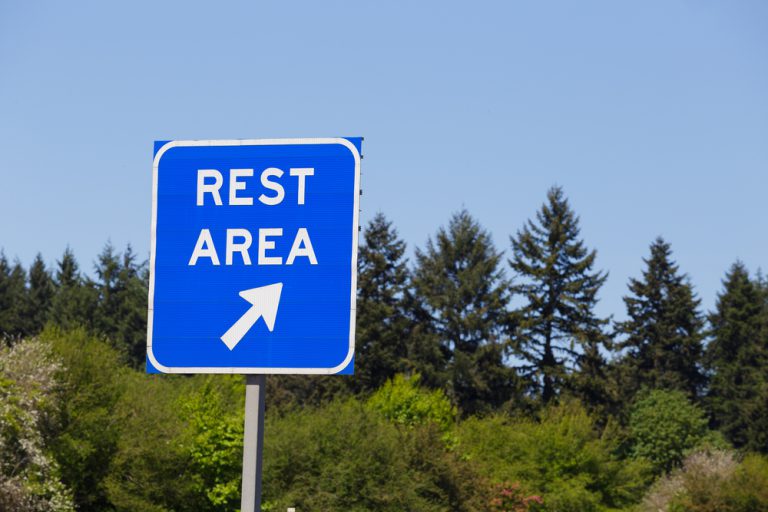
It could be a redlining fuel gauge, a grumbling tummy, or yet another cry of are we there yet?
But one way or another, you’re likely going to have to stop along the way to your next RV vacation destination. And as any frequent road tripper knows, not all pit stops are created equally.
Pick the wrong rest stop, and you’ll end up overpaying for gas, drinking day-old coffee, and compiling a lunch menu from shelves of stale junk food — that is, if you can even finagle your RV into the parking area in the first place. What’s worse, rest stop information usually isn’t available in even the best road atlas or travel guidebook (though your RV GPS might be able to steer you to rig-friendly locations).
However, a few simple tips and tricks can turn you into a pitstop professional, able to scope out the very best pitstops in advance and make the most of even so-so locations.
Here’s our best advice for making your next rest area stop the easiest, quickest, most delicious one possible.
How Long Does a Pit Stop Take?
Although the average time you spend at your pit stop will depend on your individual circumstances and the needs of your travel party, one thing’s for sure: exiting the highway to fuel up and chow down does eat into your precious vacation, and it can lengthen the amount of time you spend driving.
That’s why it’s worthwhile to make the most out of every single rest stop you take, ensuring you find the right locations that’ll offer what you need to get back on the road as quickly and efficiently as possible. For most every road tripper, that means decent coffee, healthy-ish snacks, and relatively affordable fuel choices. For RVers, however, there are a few extra factors to take into consideration.
For instance, you might need diesel as opposed to gas, and not every fueling station offers it. And if you’re driving a big rig, you may also have to worry about whether or not your vehicle will physically fit in the fueling area! Not all pit stop locations are built for oversized vehicles, particularly if you’re pulling off in a metropolitan area.
But don’t worry! Here’s what you need to know to circumvent these obstacles.

RV Pit Stop
With these easy tips, your next rest stop will be a piece of cake.
1. Plan pit stops ahead of time.
No, you can’t predict every roadside need that might arise, and it’s possible you’ll have to add additional breaks into the schedule. (Especially if you drink too much coffee on a campground-moving morning, like I always seem to).
But in general, you know about how many miles you can drive until you’ll need gas, how many hours you can go before you’ll need the bathroom, and what times of day your tummy’s gonna start complaining. That means you can plan out your rest stops ahead of time while you’re crafting your RV trip itinerary, using apps like Google Maps to find high-quality pit stops at the right points along the way. You can also use RV-specific navigation technology, like the RV CoPilot app, to help you find the best places to stop along your route.
2. Choose truck stops whenever possible.
Not only are truck stops built to handle large vehicles, but they also usually have some of the best pit stop shops and diners, well stocked with all sorts of roadside goodies. They also typically carry diesel fuel, and sometimes even propane!
Best Pit Stop Ever
Here are some more ideas for transforming your pit stops from a chore to an exciting mini-destination.

3. Make quality food choices a priority.
Yes, you can keep eating healthy on the road… and doing so will make you a much happier camper in the long run!
Gas station food used to mean choosing between Slim Jims and potato chips — not exactly the most satisfying or nutritious options. But fortunately, the rise of health-consciousness means that even mediocre rest stops often carry relatively healthy single-serving snacks, from sliced apples to packages of guacamole. We’ve even seen pre-made hard boiled eggs and salads available!
Other healthy packaged snacks include nuts, fruit snacks, and jerky, but be sure to check for added sugars and other preservatives. You can also look for pit stops with full-service restaurants, which are likely to have at least a few dishes featuring fresh produce.
Psst — want to save some cash and time on the road? Buy and pack healthy road trip snacks ahead of time. Fresh, whole almonds, nitrate-free meat snacks, and easily transportable fresh fruits, like apples and bananas, are ideal.
4. Use your time wisely.
Yes, it’s important to stretch your legs and rest every once in a while… but even the fastest pit stops add up if you’re taking too many.
Make sure you use your time wisely each time you pull off, covering all the necessities: fuel, snacks, and bathroom.
Pit Stop for Kids
Traveling with kids and pets can make finding the best rest stop a little bit more challenging. Here’s our best advice.
5. Pick places with wide-open spaces.
Fido needs to go just as much as you do, and after a couple of hours in a cramped RV, even the most patient children are aching for some playtime.
So choose rest stops located in suburban or rural areas, which are more likely to have ample outdoor space for the younger (or furrier) members of your camping party to get in a quick run around.
Want to make the time between rest stops a little more bearable for your kids? Check out this fun travel scavenger hunt card game — a great investment for less than $10!
Rest Area Near Me
Even the best planner will occasionally have to make an unplanned pit stop, and may have to compromise quality for proximity. Fortunately, our road-trip-obsessed culture means the USA is one of the best places to take that kind of gamble.
So even if you find the nearest rest stop lacking, remember: there’s another, better one waiting just down the road.
This post may contain affiliate links.






